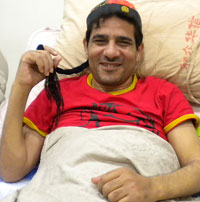Saber-Sequelae of spinal cord injury posted trauma(Egypt) Post on June 8,2010
Name: Saber Lofty Mohammed Owes 
Sex: Male
Country: Egypt
Age: 39
Admission Date: 2010-04-21
Diagnoses: Sequelae of spinal cord injury post trauma, diabetes type 2
Days Admitted to the Hospital: 35
Saber is a 39-year-old male who was involved in a car accident, then shortly after developed a sensory disorder and had difficulty moving for the past 9 months. At the time of the accident, Saber was conscious, but had difficulty with breathing. Saber was sent to a local hospital immediately; where it was discovered that he had a spinal fracture at the C6-7 segments. He underwent surgery, but there were no noticeable improvements to his condition. The breathing difficulty became more serious 2 weeks later, so the local hospital gave him a tracheotomy in order to improve his respiration. Approximately 3 weeks later Saber's tracheal cannula was removed but he still had difficulty breathing and was unable to lie on his back. After being discharged from the hospital, Saber still took medications and participated in physical rehabilitation treatment but he didn't see the results he was hoping for. After some time passed, Saber became aware of our medical center and the stem cell treatment we use to treat spinal cord injuries and Saber made the decision to come to our medical center after corresponding with our doctors.
During the examination of his nervous system, Saber was alert and could speak fluently, but the volume of his voice was slightly low. His memory, calculation and orientation abilities were all normal. Both pupils were equal in size and round, the diameter was 3.0mm. Both eyeballs could move freely and the pupils reacted normally to light stimulus. The forehead wrinkle pattern was symmetrical. The tongue was centered in the oral cavity and the teeth were shown without deflection. The uvula was positioned slightly to the right. Saber could move his neck almost normally; however he had some limitation of movement when he attempted to turn to the left. The shrugging strength of the shoulders was weak. The muscle strength of the arms was level 5-; the muscle strength of the hands was level 4-. Both hands were in a flexed position. The gripping strength was level 0. There was mild atrophy in the bilateral thenar and hypothenar. The muscle tone was normal. The muscle strength of both lower limbs was level 0, and the muscle tone was almost normal. The tendon reflexes of the upper limbs were almost normal. The bilateral patellar tendon reflex was slightly low. The bilateral abdominal reflexes were not elicited. Above the bilateral C7 and T3 segments, the sensation was normal. The sensation at the bilateral C7, T3 to T4 segments was decreased. Below the bilateral T4 segment, the superficial sensation disappeared. The bilateral Hoffmann's sign and Rossilimo's sign were negative, the bilateral palm jaw reflex was negative, the bilateral Babinski's sign was negative, and the bilateral ankle clonus was negative. The coordinated movements of both upper limbs were normal. Saber was unable to cooperate with the examination testing the coordination of the lower limbs.
After we gave Saber a complete examination, we proceeded with treatment to improve the blood circulation in order to increase the blood supply to the damaged neurons. We then administered the self stem cells activation and stem cells transplantation treatment to repair the damaged neurons. We also gave him daily physical rehabilitation training. We adjusted the treatment according to Saber's condition and the examination results.
After the completion of the treatment plan, Saber's lower limbs had passive flexion and he could control their movements for a few minutes. This represented a mild improvement. The muscle strength of both lower limbs increased from level 0 to level 1. The involuntary movements of both lower limbs increased slightly. The abdominal reflex of the right middle area and below could be elicited slightly.
After Saber was discharged from our hospital, his brother wrote to us:
"Dear Dr. Wu,
...you gave us a reason to be optimistic and we hope you are able to help other patients in the same way. You have an excellent nursing team and international department. We especially thank Lisa, Yao and Viola. They gave us so much help.
Thanks to all the staff at your hospital.
Saber"
2010-08-24
"Hello,
I am Hosny. The brother of your Egyption patient Saber Lotfy. I would like to tell you some news about Saber condation. The three moths are
almost finished onlt few days more. And I noticed that he is improving. I am depending on the test for the muscle level that you were doing to check if he got improvement of not and you told us his
muscule improved from level 0 to level 1 becease it stayed more than 20 seconds without falling.
Now his leg can stay for more than 3 minites without falling and also he can move it to left and right musch better than he used to do. And
also it doesn't fall easy it shakes many times before it fall.
Thank you Doctor for your help
Hosny Lotfy"
See Saber's vedio:
(Download the Windows Media Player Firefox Plugin if you are using Firefox browser.
To know more,Please read Using the Windows Media Player plugin with Firefox.)
